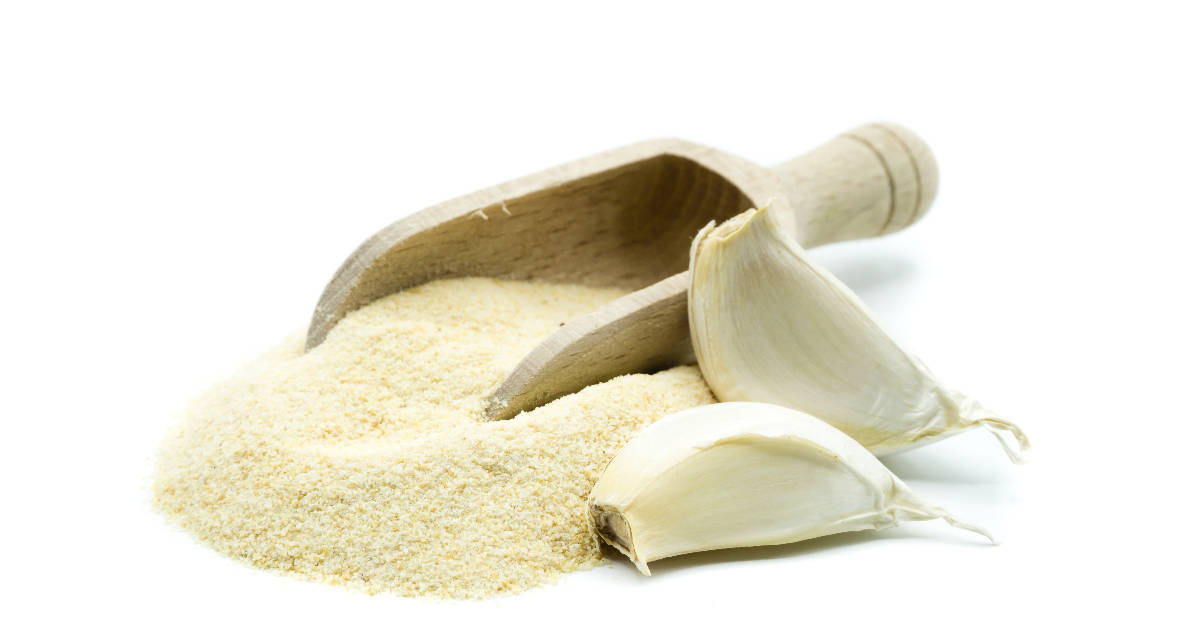Garlic is an essential ingredient in cuisines around the world. Its pungent and nutty flavor adds depth and savoriness to both savory and sweet dishes.

There are a few common forms of garlic used in cooking - fresh garlic cloves, minced garlic, garlic paste, garlic powder, and more.
Two of the most popular are minced garlic and garlic powder. But what exactly is the difference between these two, and when should they be used?
What is Minced Garlic?
Minced garlic refers to fresh garlic cloves that have been finely chopped, crushed or grated into tiny pieces. The finer the garlic is minced, the stronger its flavor since more allicin is released from the garlic cells during mincing. Allicin is responsible for garlic's distinctive pungent taste and aroma.
To mince garlic cloves, you first remove the papery outer layer, then can either roughly chop with a knife, use a garlic press, or a dedicated garlic mincer. Minced garlic offers the most robust and freshest garlic flavor compared to other forms since it still contains its natural juices and oils. It also has the texture of the fibrous garlic flesh.
Here's a quick summary:
- Minced garlic - Finely chopped or crushed fresh garlic cloves
- Strong, fresh garlic flavor with spicy notes
- Retains moisture and oils from garlic
- Has texture from garlic flesh
- Must be stored in fridge, lasts 1 week after opening
Some key ways minced garlic is used:
- Sautéing aromatics
- Adding to sauces, stews, soups
- Mixing into dressings, dips
- Garnish for pasta, pizza etc.
What is Garlic Powder?
Garlic powder consists of fresh garlic cloves that have first been sliced and dried, before being ground into an extremely fine powder. The drying and grinding process concentrates the flavor compounds, making garlic powder much more potent by volume compared to fresh garlic.
Garlic powder has a toasty, sweet and mellow flavor compared to the sharper raw garlic punch of fresh minced garlic. It incorporates seamlessly into both wet and dry ingredients of recipes without adding texture or moisture. It's also convenient since it can be stored at room temperature in a sealed container.
Summary:
- Garlic powder - Dried, ground garlic cloves
- Intense and concentrated flavor
- No moisture or texture
- Shelf-stable, lasts 2-3 years sealed
Common uses of garlic powder:
- Seasoning for meats, sauces, soups
- Dry rubs, spice blends, marinades
- Dips, salad dressings, mayo
- Baked goods like bread, cookies
Garlic Powder vs Minced Garlic
Now that the key differences are outlined, here is a detailed comparison of the two garlic forms:
| Factor | Garlic Powder | Minced Garlic |
|---|---|---|
| Form | Dehydrated and finely ground | Finely chopped or crushed fresh garlic |
| Flavor | Concentrated, mellow, sweet | Strong, pungent, spicy |
| Texture | No texture | Garlic flesh texture present |
| Moisture | No moisture | Retains garlic moisture and oils |
| Storage | 2-3 years shelf-stable | 1 week refrigerated |
| Uses | Seasonings, dry rubs, spice blends | Sautéing, sauces, dressings, garnish |
Flavor Profile
Since minced garlic consists of raw garlic cloves, it offers the most authentic and pungent garlic flavor. The spicy, biting taste comes from compounds like allicin that get activated when the garlic's cell structure is ruptured from chopping or crushing.
Garlic powder goes through a dehydration process which mellows out some notes and brings out the sweeter, toasted aspects instead. So garlic powder has a more balanced and subtle garlic essence. It provides a background of flavor instead of being the star of the dish like minced garlic.
Texture and Moisture
An obvious difference between the two garlic forms is the texture and moisture levels. Minced garlic consists of chopped bits of garlic flesh that retain the moistness within garlic cloves. So it adds textural variation along with moisture when used in cooking.
On the flip side, garlic powder dissolves seamlessly into both wet and dry mixtures without impacting texture or moisture levels. This makes it suitable for applications where you want garlic flavor without garlic pieces or added moisture.
Storage Life
Since garlic powder consists of dehydrated garlic, its storage life is significantly longer compared to fresh minced garlic stored in olive oil or water. An unopened jar of minced garlic will last around 2 weeks from opening if stored in the refrigerator. Garlic powder can be kept for upwards of 2-3 years if stored properly in an airtight container in a cool pantry.
So garlic powder is infinitely more convenient when it comes to storage and being able to have garlic flavor on hand at all times. But it does lack the same robust taste and bite of fresh minced garlic.
Minced Garlic vs Garlic Powder Conversion
When substituting garlic powder for minced garlic or vice versa in recipes, use the below conversions to get the ideal flavor balance:
- 1 clove garlic = 1/2 tsp minced garlic = 1/8 tsp garlic powder
- 1 Tbsp minced garlic = 3/4 tsp garlic powder
Garlic powder is much more potent and concentrated compared to the exact same volume of minced garlic. So use about 3-4x times less powder compared to minced when converting.
Always add garlic powder a bit at a time to prevent overpowering other ingredients since a little goes a long way.
Key Takeaway: When substituting garlic powder for minced garlic or vice versa in recipes, use 1/8 tsp powder for every 1/2 tsp minced. Adjust up or down to taste.
How to Buy and Store Minced Garlic and Garlic Powder
Buying Tips
Minced Garlic
When shopping for minced garlic, first check the ingredients list to determine if other seasonings have been added. Some versions contain extras like salt, herbs or vinegar. Choose plain if you want just garlic flavor.
Next, check how it's been preserved - olive oil and water are most common. Both work fine, just note oil-packed will impart some flavor.
Finally, give the minced garlic a sniff test before buying. It should have a strong garlicky punch without any sour, fermented or "off" notes.
Garlic Powder
For garlic powder, give the container a shake to determine how fine and consistent the grind is. Avoid powder with large grains or lots of clumping since ultra-fine is ideal for blending into recipes seamlessly.
The ingredients should list only garlic - some brands add anti-caking agents and flavor stabilizers that can dull flavor over time. Ideally no other ingredients beyond garlic are necessary.
Storage Tips
To maximize freshness of jarred minced garlic, transfer it to an airtight container and store in the refrigerator once opened. It will maintain quality this way for 5-7 days after opening.
For best retention of flavor compounds, keep garlic powder in a cool, dark space in an airtight container. Always make sure to close it tightly since humidity Exposure to air, light and warmth degrades garlic powder over time. Stored properly, it will last several years.
Uses for Minced Garlic vs Garlic Powder
Below are the best applications for using either minced garlic or garlic powder based on their differing flavor impact and textures:
Best Uses for Minced Garlic
The fresh, vibrant taste of minced garlic makes it a perfect choice for:
- Sautéing - great way to bloom garlic flavor as a flavor base
- Salad dressings, marinades, sauces - adds texture and bite
- Garnish or topping - raw garlic punch enhances flavors
- Dips like hummus, baba ganoush, tzatziki
- Pestos, tapenades
- Adding to pizza, pasta right before serving
Best Uses for Garlic Powder
Since garlic powder blends seamlessly without texture or moisture, it excels when you want garlic flavor without garlic pieces. Perfect for:
- Soups, stews, chilies - incorporates evenly to infuse flavor
- Dry rubs, marinades, spice blends
- Meatloaf, burgers, meatballs - adds flavor without texture
- Mashed, roasted potatoes and vegetables
- Salad dressings, mayo, hummus, guacamole
- Pasta sauce, pizza sauce
So in summary, minced garlic brings a vibrant blast of fresh garlic flavor and texture. Garlic powder provides a more subtle enhancement of savoriness in the background. Both have a place in every well-stocked kitchen!
FAQs
Is garlic powder as healthy as fresh garlic?
No. Fresh garlic like minced garlic retains more nutrients and beneficial compounds compared to processed garlic powder. But garlic powder still provides some nutritional value like antioxidants, vitamins and minerals.
Can you use garlic powder instead of minced garlic?
Yes, garlic powder can be substituted for an equivalent amount of minced garlic. Use about 1/8 tsp powder for every 1/2 tsp minced garlic. Garlic powder has a more mellow flavor so you may need to use more until the taste is to your liking.
Why is my garlic powder clumping?
Garlic powder's fine consistency makes it prone to absorbing ambient moisture and clumping over time. Prevent clumps by storing garlic powder properly in an airtight container rather than the original container. Glass jars work best.
Can you reconstitute garlic powder into minced garlic?
Not exactly. But you can bloom garlic powder in warm water for 5-10 minutes then mix into a recipe calling for minced garlic. This rehydrates some of the dried compounds and makes the garlic flavor more pronounced before blending into other ingredients.
Which is cheaper - garlic powder or minced garlic?
Garlic powder generally offers more value ounce-for-ounce compared to the price of jarred minced garlic. A few ounces of garlic powder can provide the equivalent flavoring of multiple jars of minced garlic. So garlic powder is the cheaper option in the long run for consistent garlic flavor in your cooking.
Conclusion
Minced garlic and garlic powder start from the same whole garlic cloves but offer differing flavors, textures and uses based on their preparation method.
Minced garlic consists of finely chopped raw garlic, retaining its natural moisture and oils. It offers the strongest, freshest garlic punch and added texture in recipes.
Garlic powder is made from dehydrated, pulverized garlic cloves, concentrating the flavor compounds into an ultra-fine powder. It incorporates discretely into both dry and wet recipes.
While fresh minced garlic boasts the brightest flavors, garlic powder's convenience and storage life lends different value. Understanding when to use each allows home cooks to maximize the flavors and versatility of recipes.

